In the past, the average employee might have been able to sail through their career with little to no typing skill. But today, it's important to master keyboard skills long before you enter the workforce.
Typing efficiently and accurately is as important for a CEO as it is for a high school student. People across many industries, from computer programmers to factory workers and law enforcement personnel, need to be able to type proficiently to succeed as professionals. Typing is a lifelong skill that pays dividends in many ways, saving valuable time you can devote to more pressing issues such as maintaining a work-life balance.
To gauge the speed and efficiency of typing skills in today's workplace, we tested the typing speed of 980 full-time workers whose job functions included finding their way around the keyboard. Have you ever tested your words per minute (wpm) typing speed? If not, or it's been a while, now's your chance. Take our quick one-minute typing test to see how you stack up to the professionals who participated in our study below. Remember, speed is important, but so is accuracy.
Speed Matters on the Keyboard
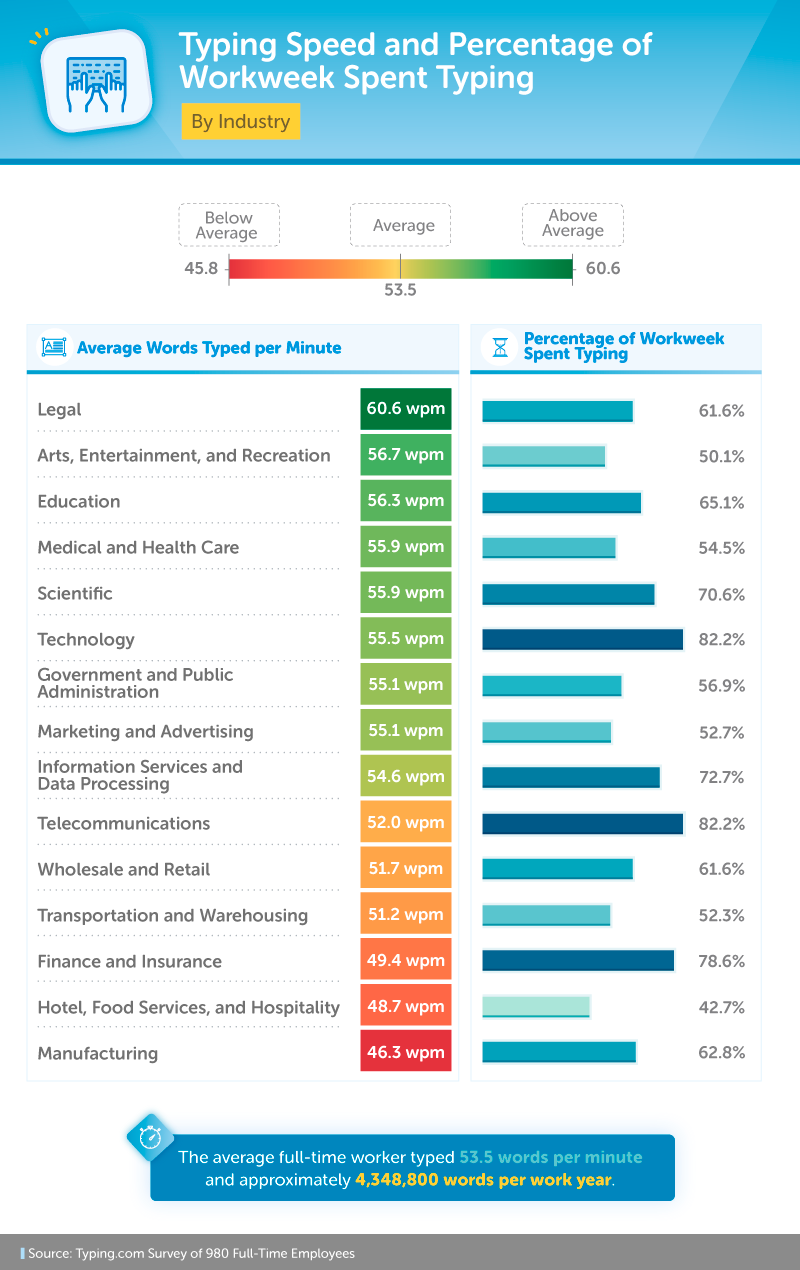
What occupations do you think have the fastest typing speeds? If the legal profession came to mind, then you're right on target. Workers in legal departments or law offices spent close to two-thirds of their workweek typing, averaging over 60 wpm. Written communication is often considered just as important as verbal conversation for successful lawyers, and with a potentially endless opportunity for writing briefs, depositions, motions, and resolutions, the faster you can type in the legal profession, the better off you will be.
It's difficult to imagine any employee in today's digital work environment who doesn't use a keyboard to perform even the most basic of tasks, given the average worker types over 4.3 million words annually. Considering the average employee spends over two hours a day just getting through his or her email, most full-time workers have plenty of time to hone their typing skills when communicating with their colleagues.
Workers in some industries, such as technology, telecommunications, and finance and insurance, spent up to and over 80 percent of their time typing. That's four days out of the average five-day workweek. Put another way, that means they type all day from Monday to Thursday, leaving Friday to perform other necessary tasks.
Although employees in the finance and insurance industry spent a majority of their workweek typing, they were some of the slowest typists in our study, averaging just under 50 words per minute.
Salary and Time Spent at the Keys
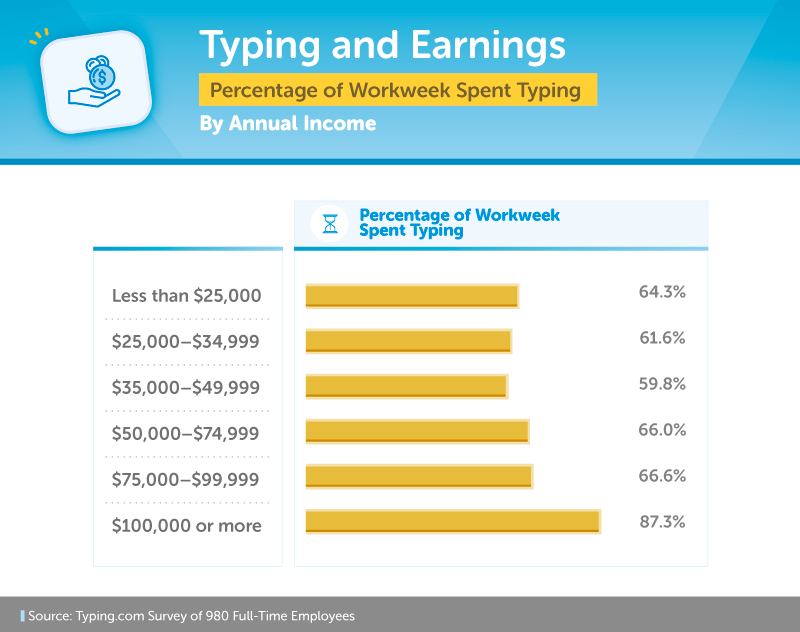
Having quick typing speed is definitely a necessary skill for many jobs, but how does it translate into annual earnings?
Typing faster than your colleagues doesn't guarantee you a fatter paycheck since other work-related skills are also important. However, our survey pointed out that workers earning $100,000 or more per year spent over 87 percent of their workweek typing. Yet another reason that improving your typing speed can increase your chances of professional success.
Typing Speed Improves in Every Generation
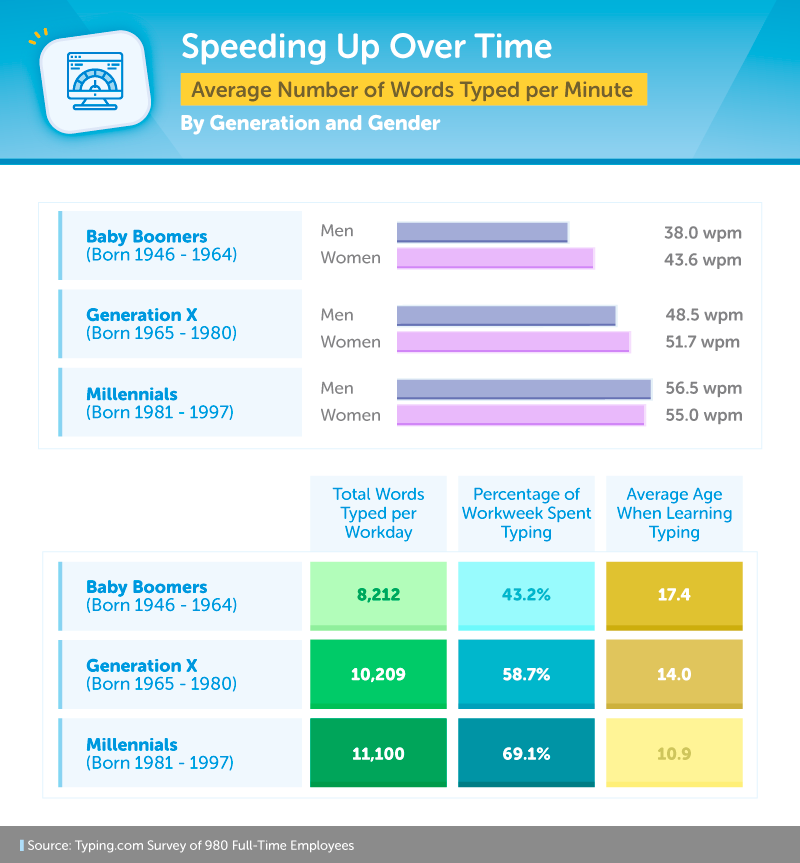
When we broke down typing speed by generation and gender, male baby boomers were the slowest, averaging only 38 wpm. Women in the same generation typed 14.7 percent more words per minute.
Overall, women's typing speeds were slightly faster than men, but millennial men departed from that trend. Millennial men outpaced their female contemporaries by a small margin, typing 2.7% more words per minute.
While baby boomers typed over 8,200 words every day, Gen Xers typed 24.3 percent more (an extra 2,000 words). Millennials typed even more, putting in 8.7 percent more words than Gen Xers. Considering millennials spend 69.1 percent of their workweek typing, it's no wonder they clock in more words across the keyboard than older employees.
Millennials also happen to make up the largest sector of working Americans today. Not only do they lend their fast typing skills to the workforce, but also they are notably versatile, flexible, and purpose-driven compared to past generations.
Improve Your Technique and Speed
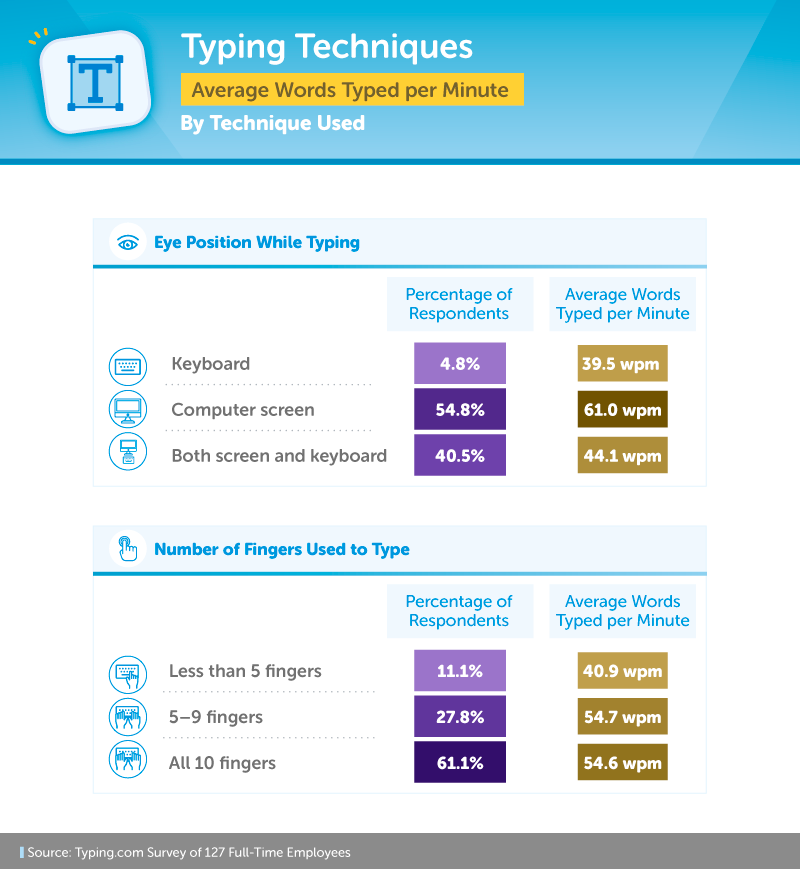
If you want to improve your skill in most any endeavor, teachers and coaches will probably suggest that you practice and learn more efficient techniques. Typing is no exception.
You probably imagine that the fastest and most effective typing method is the most common method: using 10 fingers. With the right practice, you can learn to effectively employ all 10 fingers in your typing by placing the thumbs in the optimal positions. Typing with all 10 fingers was the method used by 61 percent of respondents, allowing them to produce an average of 54.6 wpm. But as we also found, this wasn't the fastest method in our survey.
Workers who used five to nine fingers comprised just over a quarter of those surveyed but averaged 54.7 wpm, just a touch faster than those who used all 10 fingers. This implies typing speed can be achieved in multiple ways, but using improper techniques can lead to typos – and potentially costly consequences. With practice, though, even long-held bad habits can be ironed out.
To maximize speed and accuracy, typing experts suggest students train themselves not to look down at their fingers or the keyboard by developing muscle memory. Fortunately, over half of our respondents primarily used this technique, averaging 61 wpm and almost 17 words faster than those who looked at both the keyboard and screen when typing.
Less than 5 percent of typists primarily looked at the keyboard and trailed the other two methods with a lackluster 39.5 wpm.
If you're looking to improve your skill and, ultimately, the number of words you can type per minute, regular practice can make a huge difference.
Emotions Can Affect Keyboard Speed
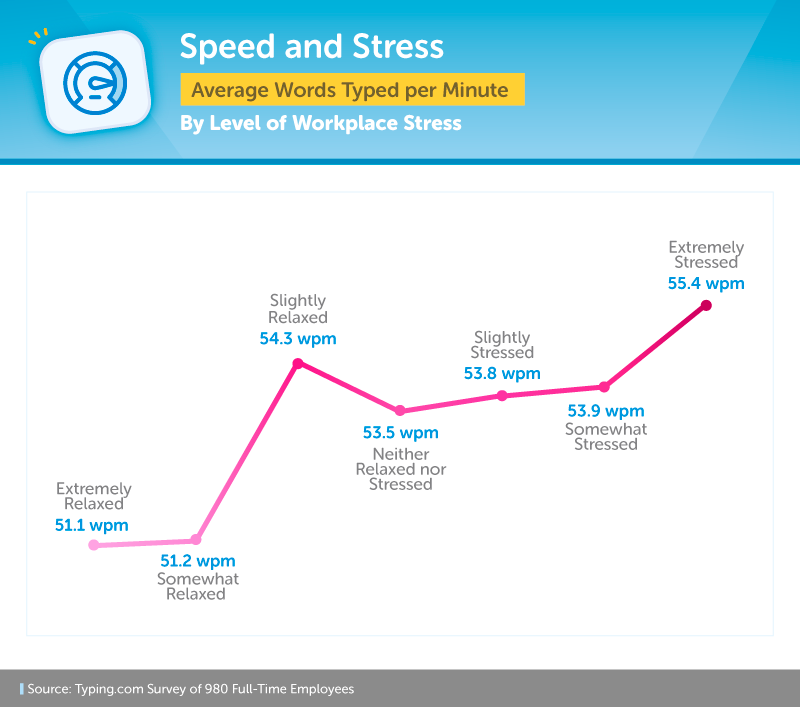
If you find yourself typing faster than your colleagues, sending out emails in record time, firing off lengthy reports, or outpacing everyone with your meeting notes, there's a chance you may be under stress at work. On the other hand, it's possible those with high-stress jobs must type quickly to cover their workload. Let's take a closer look at the survey results.
Those who felt "extremely relaxed" at work had an average typing speed of 51.1 wpm – almost identical to workers who were "somewhat relaxed," who typed one-tenth of a second faster. The axis line for typing speed jumped north for those only "slightly relaxed" at work, decreasing slightly for those neither relaxed nor stressed and gradually increased again until leaping to 55.4 wpm for typists who felt "extremely stressed" in the workplace.
Feeling stressed at work isn't just dangerous for your workplace efficiency – it can create a toxic mindset that affects everything from sleep to your home life. Stress can even have a contagious effect among colleagues. Avoiding stress at work isn't always easy though, and you might not realize how much pressure you're under until it's too late.
Be mindful of how fast you're dashing through tasks and typing up emails throughout your workday. If your haste is closely tied to stress, take that as a sign to take a break by going for a quick walk or grabbing a healthy snack. Stepping back and slowing down at work can help you avoid typos, stay on deadline, and may keep you from getting sick.
Typing Your Way to an Improved Work-Life Balance
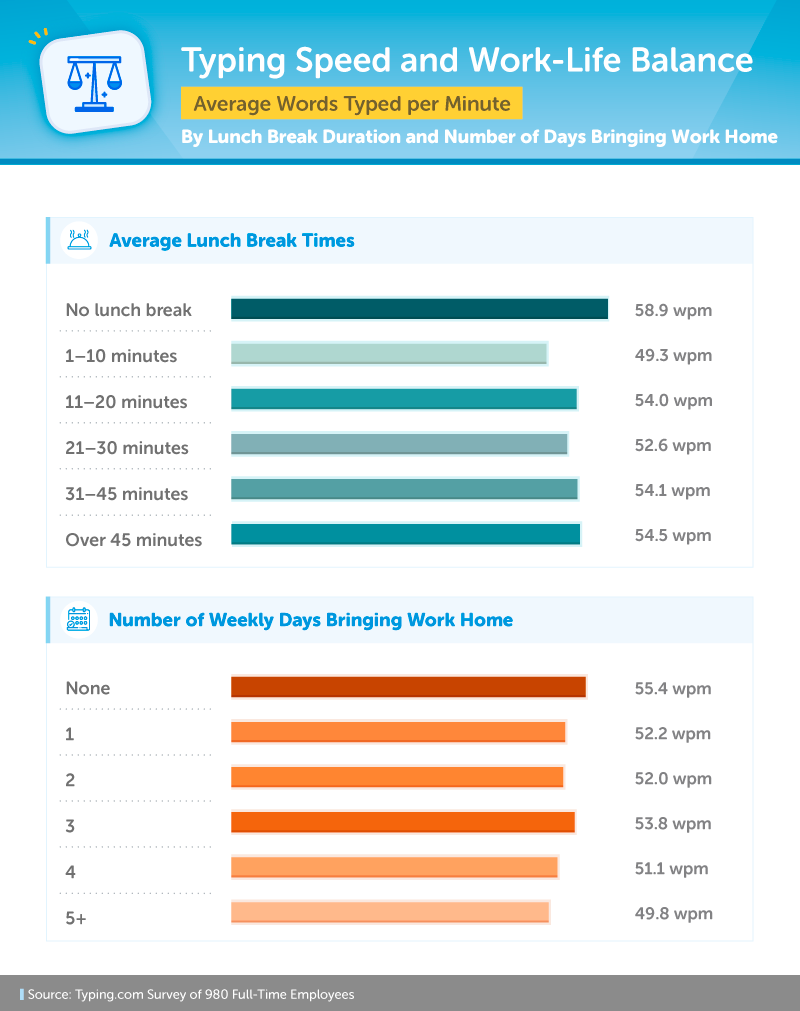
Most workers go through busy seasons where they have to work through lunch or bring assignments home. However, for some, bringing work home and cutting back on breaks could become a chronic, regular occurrence. We set out to see if there was any connection between typing speed and the frequency of bringing work home.
Workers who took a midday break of more than 45 minutes had the fastest average typing speed at 54.5 wpm. Workers who paused to eat for just 10 minutes or less typed 49.3 words per minute, which is a 10 percent difference. Besides those who skipped lunch regularly, we found that the longer the lunch break, the faster the typing speed.
We also noted a similar trend in the number of nights per week employees had to bring home additional work. Workers who never usually brought their work home typed 55.4 words per minute on average, and those who brought work home five or more nights per week typed 49.8 words per minute.
Typing quickly and accurately may make employees more efficient during the day and could help them finish a few more tasks, leading to a greater work-life balance. Research suggests employees who don't have an effective work-life balance are often more exhausted, compromising both their mental and physical health.
Learn Early, Type Faster
Studies have shown that when children are exposed to a secondary language, it becomes easier to master. We found the same holds for typing.
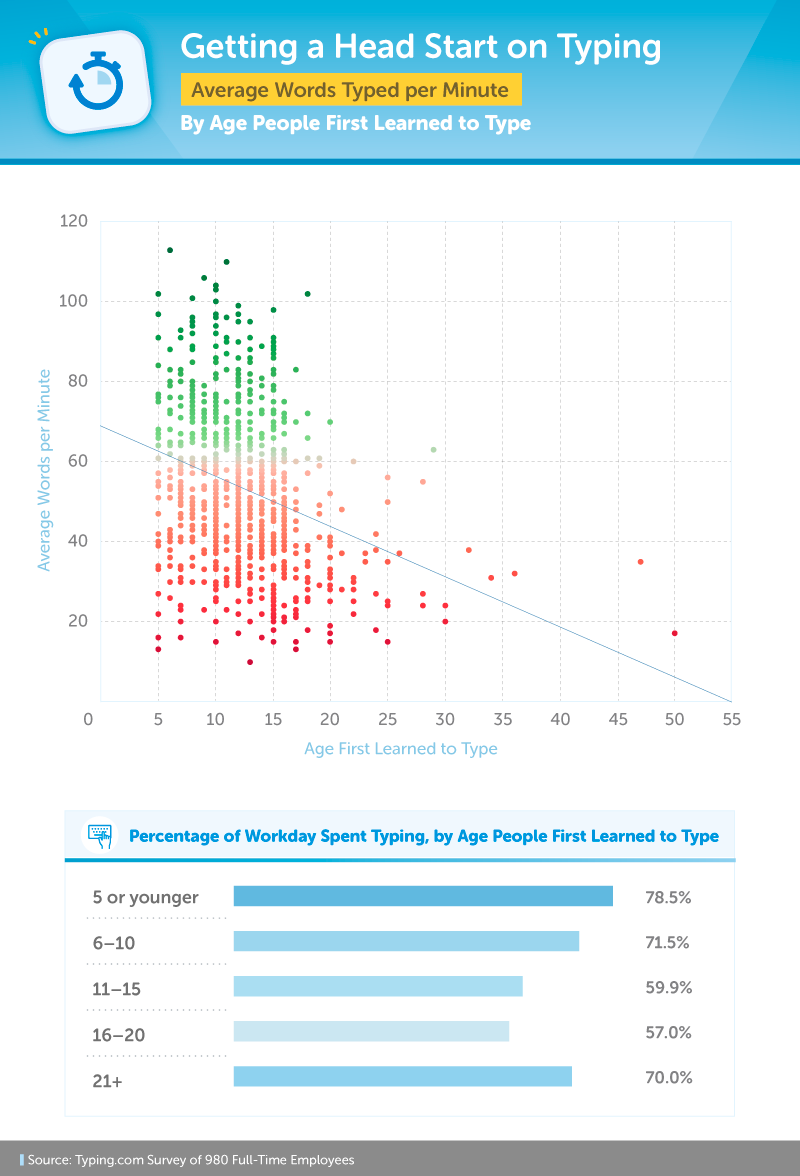
Children who started learning to type at age 5 or younger spent over 78 percent of each workday typing later in life. For kids who started working on their typing skills between the ages of 6 and 10, our survey showed they spent over 71 percent of their average workday utilizing a keyboard.
Those spending the least amount of time typing on the average workday began typing between the ages of 16 and 20 – often the same years that many students begin honing skills they will use later in their chosen professions.
Take a moment and consider the occupations where advanced typing skills play a significant role in success. You certainly want the doctor, nurse, or medical assistant transcribing your medical records to have proficient typing skills. What about the attorney, paralegal, or legal assistant with the firm you retained to handle a pressing legal matter? Or the computer programmer working on a code that will improve the functions of your favorite mobile app?
Think about how much essential information most people absorb each day in news reports, medical prescription instructions, cookbooks, financial statements, and letters that pile up on desks and kitchen counters. In many of these situations, typos and incorrect information could cause confusion at best and physical harm at worst. Having strong typing skills can help people in nearly every profession and age contribute to the world more effectively and communicate with others more clearly.
It's Never Too Late to Improve Your Typing Skills
The technology we use today will advance rapidly, and even as voice command technology improves, typing will remain a valuable and sought-after skill.
Whether you missed the chance to hone your typing skills at a young age or are looking to strengthen your current typing technique, Typing.com is here to help.
Not only can typing practice improve your existing skill and possibly pay dividends at work, but also the practice tests and games at Typing.com are engaging and interactive – and, best of all, let you learn at your own pace.
Methodology
For this study, we surveyed 980 full-time employees who spent at least some of their workdays typing on computers. On average, those surveyed spent 22.3 hours of their workweeks typing. We conducted the survey using Amazon's Mechanical Turk. 45.1 percent of respondents were female, 54.6 percent were male, and fewer than 1 percent were nonbinary. 92 percent were full-time employees who worked in a shared workspace like an office, and 8 percent were full-time remote employees. The average age of participants in this study was 35.6, and the standard deviation was 9.2. Participants ranged in age from 19 to 73 years old.
All respondents in our study agreed to take a one-minute typing speed and accuracy test on Typing.com and input their results. Speeds that were greater or less than three times the standard deviation plus the mean were excluded from our analysis.
To determine the percentage of the workweek that employees spent typing, we divided the self-reported hours they spent typing with the number of hours they reported working each week.
To determine how many words employees typed per year, we multiplied words per minute by the number of minutes in a standard work year: 4,348,802 (2,080 hours). Then, we multiplied this by the percentage of hours employees spent typing each week.
We also ran a supplementary survey approximately three weeks after the initial survey. 127 of the original 980 respondents opted to participate in a secondary survey in which we asked how many fingers they typically used when typing and where they tended to look while typing (screen and/or keyboard).
Limitations
Since we only surveyed computer-literate full-time employees, the average typing speeds are going to be somewhat different than they would be if we had surveyed and tested people working in a variety of industries and with various levels of computer familiarity. Additionally, it is important to note that the typing you may do during a speed test is different than the way you might type while completing work assignments, so the results may not be entirely reflective of the typing speeds of workers during a standard workday.
The sample size for the number of people who looked at the keyboard while typing was only six people. The sample size of people who used five fingers or less was 14. With more participants in both of these groups, it's possible we would have gained more insight and different results.
This study is meant to be exploratory and is based purely on means.
Sources
- https://learning.linkedin.com/blog/productivity-tips/three-reasons-you-really-should-learn-to-type
- https://www.typing.com/student/tests
- https://www.thebalancecareers.com/top-ten-legal-skills-2164595
- https://www.forbes.com/sites/annabelacton/2017/07/13/innovators-challenge-how-to-stop-wasting-time-on-emails/
- /typing-jobs/
- http://time.com/3821403/administrative-professionals-history/
- http://www.pewresearch.org/fact-tank/2018/04/11/millennials-largest-generation-us-labor-force/
- https://www.nbcnews.com/better/business/7-ways-millennials-are-changing-workplace-better-ncna761021
- /hunt-and-peck/
- /expensive-typos/
- /break-bad-typing-habits/
- /muscle-memory/
- https://www.typing.com/student/lessons
- https://www.cnbc.com/2017/12/14/the-harmful-effects-of-stress-at-work-and-what-you-can-do-to-beat-it.html
- https://www.inc.com/will-yakowicz/stop-rushing-through-work-stress-is-contagious.html
- https://www.themuse.com/advice/yes-its-possible-to-work-too-fast-here-are-4-signs-its-time-to-slow-down
- https://www.inc.com/matthew-jones/taking-work-home-with-you-12-easy-ways-to-leave-work-where-it-belongs.html
- https://nypost.com/2017/12/14/why-you-should-never-take-your-work-home-with-you/
- https://bilingualkidspot.com/2018/05/10/shouldnt-wait-teach-child-language-while-young/
- https://work.chron.com/kind-jobs-need-keyboarding-skills-15369.html
Fair Use Statement
If you are working on a story and find this content useful, feel free to share it with others as long as it's for noncommercial purposes. All we request is you link back to this site so that readers can read the complete results on the importance of typing skills.

 UK English
UK English
 Español
Español
 Português
Português



